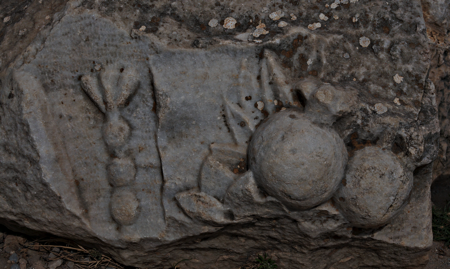- Analysis of Correlations Between Climate and Molecular Adaptive Evolution of Wild Barley with Geographical Information Systems (GIS). Some genes are associated with climatic variables in wild barley, others not so much.
- Molecular Genotyping of Historical Barley Landraces Reveals Novel Candidate Regions for Local Adaption. Latitudinal structuring in northern European barley landraces down to 7 SNPs. Not clear if related to above.
- Morphological and genetic diversity assessment of sesame (Sesamum indicum L.) accessions differing in origin. Not much geographic structure.
- Ploidy and domestication are associated with genome size variation in Palms. Tall coconuts show more variation in genome size than dwarfs.
- Protected areas effectiveness in maintaining viable giant anteater (Myrmecophaga tridactyla) populations in an agricultural frontier. I just wanted to link to a paper on the giant anteater.
- Genetic Diversity in Seedling Populations of Mango. What exactly are “sucking purposes”?
- Diversifying crops for food and nutrition security — a case of teff. Hipsters will save orphan crops.
- Conservation of Rice Genetic Resources for Food Security. In the Philippines genebank, that is.
- Soybean [Glycine max (L.) Merrill]: Importance as A Crop and Pedigree Reconstruction of Korean Varieties. 168 of 178 varieties released in the last 100 years in Korea can be traced to 4 pedigrees.
- In-situ Conservation of wild forest coffee — Exploring the potential of participatory forest management in south west Ethiopia. It’s the communities, stupid.
- Switchgrass Germplasm Resources. Upland and lowland ecotypes, different ploidy levels, latitudinal differentiation, and a national collection at USDA to play with.
- Participatory evaluation of Guinea yam (Dioscorea cayenensis Lam.–D. rotundata Poir. complex) landraces from Benin and agro-morphological characterization of cultivars tolerant to drought, high soil moisture and chips storage insects. 5-15% of over 400 varieties (including duplications) are good for one thing or another.
Nibbles: Seed Treaty, Grelo festival, Large tomatoes, Saffron collecting, Enset redux, Grassland diversity, Census 2016, Organic definition, Dalit seeds, Ancient wheat DNA, Ancient American farmers, Tree adaptation, Syrian crops at OFN
- What civil society said at the latest Governing Body meeting of the ITPGRFA earlier this month.
- Google Translate fail puts spotlight on the cruciferous crop I’ve always known as fiarielli but which is sometimes called rapini. Both names kinda suck.
- That’s one huge tomato.
- That’s one expensive spice.
- Rediscovering enset.
- Grassland biodiversity good for resilience to climate change.
- Global agriculture: here comes the data.
- Deconstructing organic. The word, that is.
- Empowering dalit farmers by recognizing their knowledge of seeds.
- That ancient underwater wheat DNA wasn’t so ancient after all. Maybe.
- It was migrants who forced the ancestors of the Pueblo people to move.
- Local adaptation in trees: what has it ever done for us?
- Another way to safeguard Syrian crop diversity.
Nibbles: EATx Cali, Gourds, Armenian wine, Wheat chemistry, Genomics of domestication, Soybean breeding
- Svalbard among things being discussed at EATx Cali today. Who knows, maybe other genebanks too?
- The cucumber’s wilder relatives.
- Armenian wine going back to the future.
- Whole grains deconstructed.
- Unpicking domestication in chickens and cattle. And the original paper on the latter, featuring the aurochs genome.
- Breeders have bred omega-3 alpha-linolenic acid (ALA) out of soybeans, but are now going back to wild relatives to breed it back in.
Ephesian mystery
As you may have realised, Luigi and I were both in Izmir, Turkey, for the past few days. While there, we joined a trip to the ruins at Ephesus. And while there, I snapped this picture.

The thing on the right is quite obviously a pomegranate, still very much in evidence at juice stands everywhere. But what’s that thing on the left? A stylised palm? A radish? What?
Brainfood: Forage diversity, Chinese cherry, Meta-diversity, Sunflower ecogeography, Lima bean domestication, Dog breeding, Goat ethnogenetics, Pigs vs chickens
- Complementary effects of species and genetic diversity on productivity and stability of sown grasslands. Species diversity good for total production, genetic diversity good for regular production throughout the year, regardless of water. And more, and more.
- Genetic Diversity and Population Structure Patterns in Chinese Cherry (Prunus pseudocerasus Lindl) Landraces. Perhaps 2 domestication sites.
- Inter-individual variation promotes ecological success of populations and species: evidence from experimental and comparative studies. More diverse populations are less vulnerable to environmental changes, more stable in population size, less extinction prone, have better establishment success and larger ranges, especially under stress.
- Ecogeography and utility to plant breeding of the crop wild relatives of sunflower (Helianthus annuus L.). Many close relatives of the crop in extreme environments.
- Domestication of small-seeded lima bean (Phaseolus lunatus L.) landraces in Mesoamerica: evidence from microsatellite markers. Two domestications events. Maybe.
- Trends in genetic diversity for all Kennel Club registered pedigree dog breeds. Popular sires have made for a lot of inbreeding, but this has been getting better of late.
- The N’Dama dilemma: ethnogenetics and small ruminant breed dynamics in the tsetse zone, The Gambia. Saving the name is not enough.
- The Pig and the Chicken in the Middle East: Modeling Human Subsistence Behavior in the Archaeological Record Using Historical and Animal Husbandry Data. Chickens replaced pigs in the first millennium Middle East because they were smaller and more efficient. Oh, and eggs.